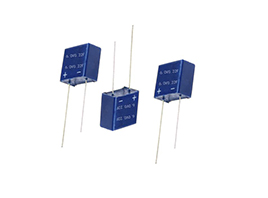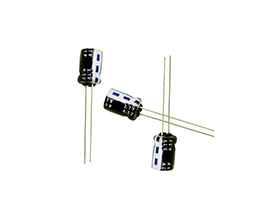Consulting phone:
135-3037-2041
(Mr.Wang)
Tantalum Electrolytic Capacitors :
A sintered tantalum block is used as the positive electrode, and solid manganese dioxide is used as the electrolyte. The temperature characteristics, frequency characteristics and reliability are better than general electrolytic capacitors , especially the leakage current is extremely small, the storage performance is good, the life is long, the capacity error is small, and the volume is small, and a great capacitance-voltage product can be obtained per unit volume. Its resistance to pulsating current is poor, and if damaged, it is prone to short-circuit. Often used in ultra-small and high-reliability parts.

Monolithic capacitors
Several pieces of ceramic film blanks are covered with electrode paddle materials, which are then wound together to form an inseparable whole, and the outer surface is then encapsulated with resin. It is a new type of capacitor with small volume, large capacity, high reliability and high temperature resistance. Low-frequency monolithic capacitors with high dielectric constant also have stable performance, small volume and large capacity error. Generally, two aluminum foils are used as electrodes, and the capacitor paper with a thickness of 0.008-0.012mm is separated and rolled in the middle. The production process is simple, the price is cheap, and a large electric capacity can be obtained.
ceramic capacitor:
The capacitor ceramics (barium titanate and titanium oxide) with high dielectric constant are extruded into circular tubes, discs or discs as the medium, and silver is plated on the ceramics as electrodes by the sintering method. It is divided into two kinds of high-frequency porcelain and low-frequency porcelain. Capacitors with a small positive temperature coefficient of capacitance are used in highly stable oscillation circuits as loop capacitors and pad capacitors.
Low-frequency ceramic capacitors are limited to bypassing or blocking DC in circuits with lower operating frequencies, or occasions (including high-frequency) that do not require high stability and loss. Such capacitors should not be used in pulsed circuits because they are prone to breakdown by pulsed voltages.

High frequency ceramic capacitors:
It is suitable for high frequency circuit mica capacitors. In terms of structure, it can be divided into foil type and silver type. The silver-coated electrode is directly coated with a silver layer on the mica sheet by vacuum evaporation or sintering. Due to the elimination of air voids, the temperature coefficient is greatly reduced, and the capacitance stability is also higher than that of the foil type. The frequency characteristics are good, the charge value is high, and the temperature coefficient is small, so it cannot be made into a large capacity. Widely used in high-frequency electrical appliances and can be used as a standard capacitor.
Glass Glaze Capacitors:
It is formed by spraying a special mixture with a concentration suitable for spraying into a thin film. The medium is then sintered with a silver layer electrode to form a "monolithic" structure. Its function is comparable to that of mica capacitors. Operating at 200°C or higher, the rated operating voltage can reach 500V.
Metallized polypropylene capacitors:
Generally in low-frequency circuits, generally can not be used at frequencies higher than 3 ~ 4MHz. The withstand voltage of oil-immersed capacitors is higher than that of general paper capacitors, and the stability is also good. It is suitable for high-voltage circuit trimmer capacitors (semi-variable capacitors). capacitance value.
Ceramic trimmer capacitors have high charge and small volume, and can generally be divided into two types: round tube type and disc type. Mica and polystyrene media generally use spring type, with simple structure, but poor stability. Wire-wound ceramic trimmer capacitors are used to change the capacitance by removing the copper wire (outer electrode), so the capacitance can only be reduced, and it is not suitable for use in occasions requiring repeated debugging.